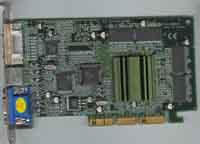
Original Link: https://www.anandtech.com/show/358
 Founded
in 1984, Gainward started out making video cards in Taipei, Taiwan. Since then,
they've grown rapidly and have worked with almost every major video chip manufacturer.
Not many had heard of Gainward, partially due to their large OEM focus, but
many of the "generic" video cards you find are in fact made by Gainward.
Ever seen a CARDEXpert board? That's Gainward. Actually, they also do a lot
of OEM manufacturing work for larger, better known video card manufacturers.
They won't say who, but rest assured that the list includes some of the most
famous video card manufacturers in the world.
Founded
in 1984, Gainward started out making video cards in Taipei, Taiwan. Since then,
they've grown rapidly and have worked with almost every major video chip manufacturer.
Not many had heard of Gainward, partially due to their large OEM focus, but
many of the "generic" video cards you find are in fact made by Gainward.
Ever seen a CARDEXpert board? That's Gainward. Actually, they also do a lot
of OEM manufacturing work for larger, better known video card manufacturers.
They won't say who, but rest assured that the list includes some of the most
famous video card manufacturers in the world.
So we weren't surprised at all when Gainward set out to produce a TNT2 based product. After all, they're sort of the Shuttle of the video card industry - making a board with seemingly every chip available. Traditionally, we've found Gainward cards to be fairly plain with few frills, but always solid products. How did the TNT2 fare in an extremely competitive market? Let's find out...
Specifications
(courtesy Gainward)
Based on NVIDIA’s RIVA TNT2 TwiN-Texel 32-bit 2D/3D Multimedia Graphics Engine
- 128-bit Wide Frame buffer Interface Supports up to 32 MB SDRAM
- 300 MHz Palette-DAC Supports up to 2048x1536 @ 60Hz
- 66 MHz AGP Clock Rate and Full Sideband AGP 4X/2X Mode
- DVD Sub-Picture Alpha-Blended Compositing
- Video Acceleration for DirectShow MPEG-1, MPEG-2 and Indeo
- LCD Resolution up to 1280x1024 and Color Depths up to 16 Million
Features
- RIVA TNT2 TwiN-Texel 32-bit Graphics Engine
- 2 Texture-mapped, Lit Pixels per Clock
- Single Pass Multi-texture Rendering
- 24-bit or 16-bit Z-buffer, 8-bit Stencil Buffer
- High Performance 128-bit 2D/GUI/DirectDraw Acceleration
- 128-bit Wide Frame buffer Interface Supports up to 32 MB SDRAM
- 300 MHz Palette-DAC Supports up to 2048x1536 @ 60Hz
- Variable Length Burst DMA Bus Mastering for Data transfers over 900 MB/s Throughput
- 66 MHz AGP Clock Rate and Full Sideband AGP 4X/2X Mode
- TextureBlend Supports Multi-texturing, Bump-mapping, Texture-modulation,
- Light Maps, Reflection Maps, Detail Textures, Environmental Maps, Procedural Textures
- 32-bit ARGB Rendering with Destination Alpha
- Point Sampled, Bilinear, Trilinear and 8-tap Anisotropic Filtering
- Per Pixel Perspective Correct Texture Mapping (Fog, Light, and MIP-Mapping)
- Wide Cache RAM and 256-bit Data path
- 128-bit Graphics with over 2.4GB/s Throughput
- Minimal Software Overhead on Key GDI Calls and DirectDraw
- Optimized Direct Frame Buffer (DFB) Access with Write-combining
- Palette-DAC Pipeline Accelerates Full-Motion Video Playback, Sustaining Fast Frame Rates with High Quality Color Resolution
- True Bilinear Filtering for Scaled Video, and Compensation for Filtering Losses with Edge Enhancement Algorithms
- Back-end Hardware Video Scaling for Video Playback
- Multiple Video Windows with Hardware Color Space Conversion and Filtering
- DVD Sub-Picture Alpha-Blended Compositing
- Video Acceleration for DirectShow MPEG-1, MPEG-2 and Indeo
- Supports PanelLink Digital Interface for LCD Monitor
- LCD Support for VGA,SVGA,XGA,SXGA 18/24 TFT Color Monitors
- LCD Resolution up to 1280x1024 and Color Depths up to 16 Million
- VESA EDID Support for LCD Type Auto-detect
DRIVER SUPPORT
- Microsoft Windows 98/95/NT4.0.
- Microsoft Windows 2000(Optional)
- Direct X
- OpenGL ICD
The Card
The first thing Gainward did to differentiate their TNT2 from the rest of the market was to design a custom PCB. While the layout is basically like NVIDIA's reference design, they got rid of a lot of the extraneous unused space. That doesn't do a whole lot for performance or features, but what it does is allow Gainward to produce these guys at a lower cost, and that translates into savings for the consumer without sacrificing quality. Everything is still there though - TV out provided by the Brooktree BT869 and Digital Flat Panel (DFP) support by a SiI DFP controller. Both of these features are manufacturing options, so make sure you know what you're ordering.
The CARDEXpert TNT2 is based on the "standard" version of the TNT2 chipset, which according to NVIDIA, indicates that the core clock speed and the memory clock speed should be no less than 125MHz and 150MHz respectively. However, NVIDIA has left the exact clock speeds up to the manufacturers and many have chosen to ship at higher than these recommended clock speeds.
Our review sample featured 32MB of SDRAM in the form of four 7ns 8MB Samsung chips on the front of the board. As we noted in AnandTech's July '99 RIVA TNT2 Roundup, 7ns SDRAM is actually officially rated to only run at 143 MHz, but that most manufacturer's felt confident in running them at 150 MHz to meet the NVIDIA recommended memory clock speed. The Gainward engineers, however, decided to play things by the book and the default memory clocking here is 143 MHz. Just like with the Gigabyte GA-660 that used the same Samsung 7ns SDRAM, we were able to reliably overclock the memory to 160 MHz.
The TNT2 core is cooled by Gainward's unique semicircular heatsink that does a good job of cooling the core. It's attached by thermal tape, which isn't as efficient as heatsink compound when applied properly, but is much better than improperly applied heatsink compound. Since we've seen a number of video card heatsinks with improperly applied heatsink compound, maybe some manufacturers that are in a big rush should check out the thermal tape method. With this cooling in place, we were able to obtain overclocked speeds of 150 MHz - the default for a TNT2 Ultra, but somewhat below that obtained by other TNT2's. However, those other cards also featured active cooling, which most likely made the difference.
The 2D image quality of the CARDEXpert TNT2 follows the pattern of other TNT2's out there - it is fine at resolutions up to 1280 x 1024, but at 1600 x 1200 the image quality takes a noticeable dive. Although it is noticeably better than the best TNT cards in terms of 2D image quality most TNT2 based cards, aren't too friendly on your eyes at 1600 x 1200 and above. If you're really looking for a combination of a professional/gaming card then Matrox's G400/G400MAX is probably what you should be setting your sights on, unfortunately getting one of those hot items is easier said than done.
Drivers
Recently, we've finally started seeing video card manufacturers including customized graphics utilities with their cards and Gainward is no exception. The only difference is that Gainward has been doing this for quite a while with their Expert Tool. They also went the extra mile to ensure that their utility would run under NT. It's completely separate from the drivers, so you can run it along side NVIDIA reference drivers or anything else you fancy.
Overclocking of the memory is available with settings from 120 to 170 MHz. Unfortunately there are no settings for the core clock or safety measures to prevent a system from booting in an unstable state. Detailed power savings options are available that go beyond the simple control that Windows 98 offers. Pretty much everything else is typical.
Gigabyte GA-660 - Driver Pictures
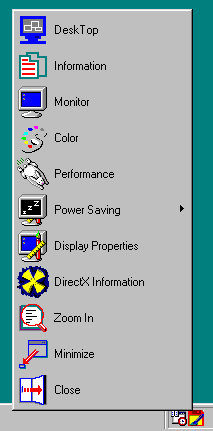
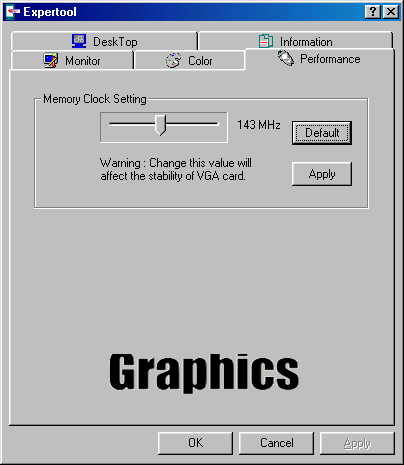
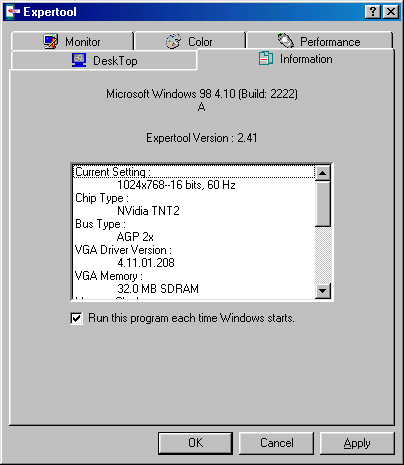
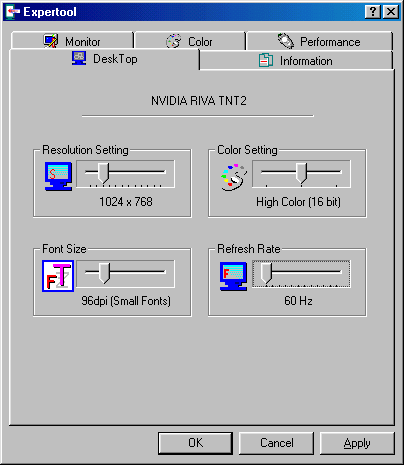
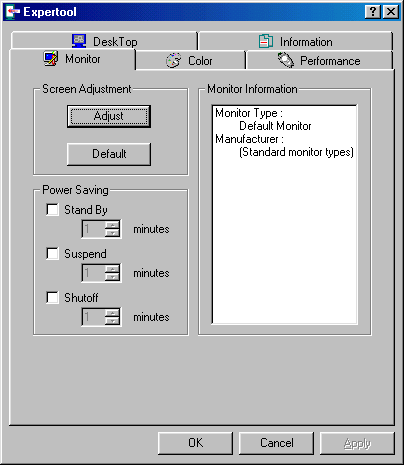
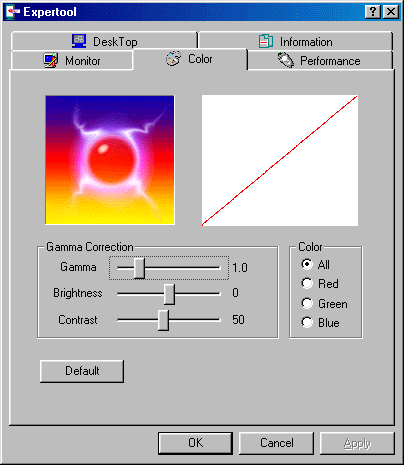
Performance
The performance of the Gainward CARDEXpert TNT2 is virtually identical to that of other TNT2 cards out there at the same clock speed. Rather than publishing the same benchmarks over and over again, we encourage you to check out AnandTech's Dynamite TNT2 Ultra Review, our original NVIDIA RIVA TNT2 Review, and the latest July 1999 TNT2 Roundup. Just remember that the Gainward CARDEXpert TNT2 is clocked at a default of 125/143 with overclockability up to 150/160.
Final Words
As usual, Gainward has come up with a fairly standard TNT2 with a couple of additional changes to set them apart from everyone else. First, it's actually possible to get this card with the DFP connector and controller onboard. Their Expert Tool is a simple little utility that come in quite handy - especially for you NT users out there. But most importantly, by shrinking the size of the PCB and not including a game bundle, the CARDEXpert TNT2 is one of the least expensive on the market today - provided of course that you can find it.
The only real issue is the clocking of the memory and the card's availability. Unfortunately, Gainward decided to clock the memory strictly by the books, the memory manufacturer's books. So at 143 MHz, the CARDEXpert TNT2 has the lowest default memory clock of any TNT2 we've looked at so far. Fortunately, it's no trouble to overclock the memory right back where it should be. As for availability, Gainward cards are often purchased and labeled as "generic" cards and you definitely won't find them at the local Best Buy. Fortunately, the CARDEXpert name is becoming more and more prominent in the marketplace, so hopefully this won't be a problem for too long.
If you do run across a CARDEXpert TNT2 at a good price, don't hesitate to buy it - it's a solid TNT2.

